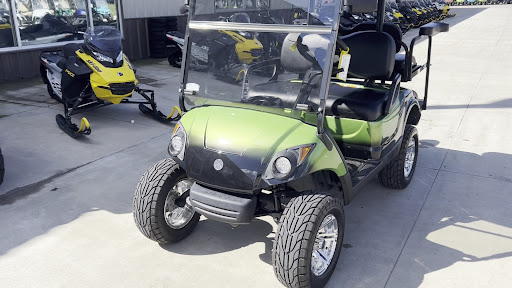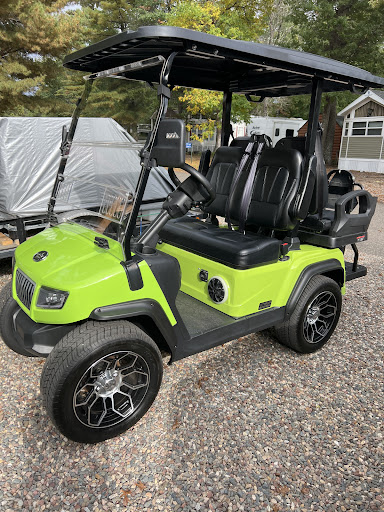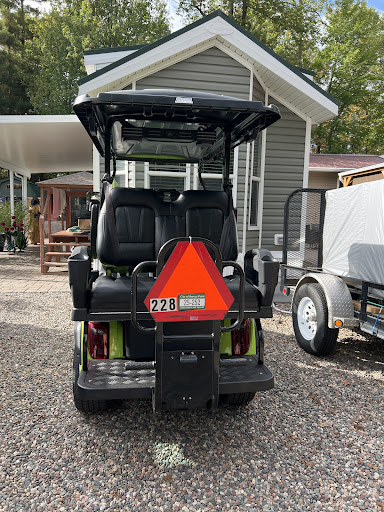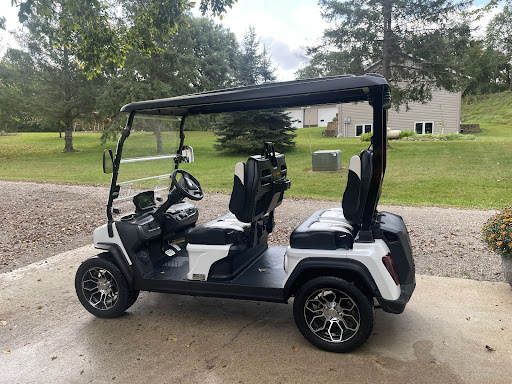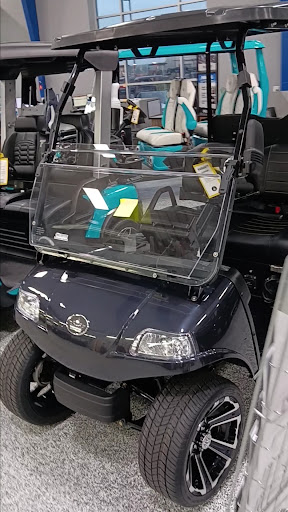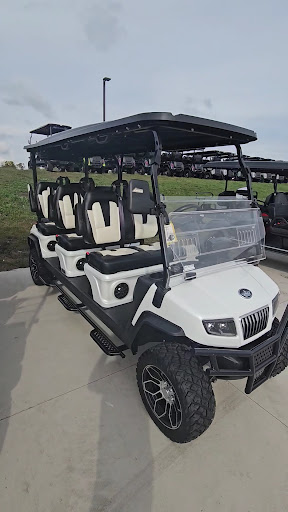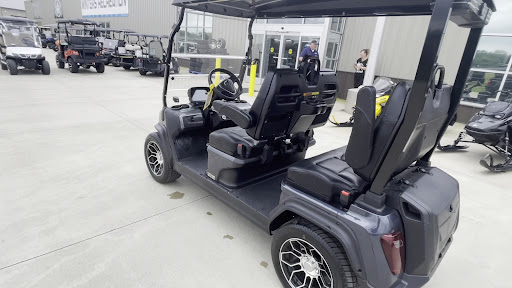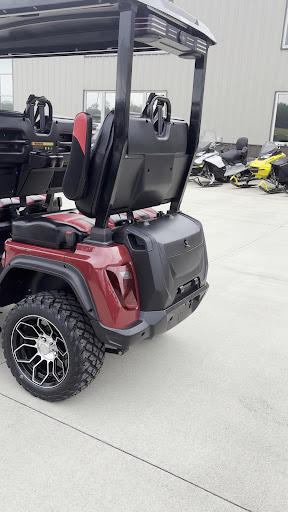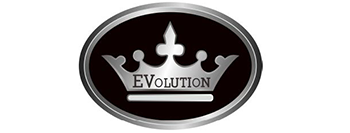Your cart is currently empty!
Help & FAQs
Help & FAQs
Only those that are LSV are going to be street legal.
The length of the warranty, and what it covers, depends on the vehicle.
- 1 Year Warranty on Accessories
- 2 Year Warranty on Lifted Gas & Electric (Not transferrable)
- 3 Year Warranty on Non-Lifted Gas & Electric (Not transferrable)
- 6 Year Warranty on Lithium Batteries (Lithium ion battery warranty is transferrable 1 time.)
Contact your dealer or distributor or review the warranty section in your owner’s manual for more information.
Winters Recreation also offers Extended Service Contracts through AGWS. Learn more about AGWS.
Onward: Up to 19 mph
Precedent: 12-14 mph
Tempo: Up to 15 mph
There are many variables to this. It varies greatly upon the slope of the hill, the number of passengers in the cart, and the speed at which the driver is operating the cart.
Yes, please complete this form to connect with our Parts Department, find pricing, and availability.
Clean your cart body, battery terminal, & tires
For Gas Powered Carbureted Carts:
- Turn the fuel shut-off valve to the “off” position.
- Run the cart in Neutral until the engine stalls; this indicates that all the fuel in the carburetor has been used.
- Disconnect the battery and spray the terminals with a protector spray.
- Inflate the tires to 12 to 14 psi and secure the cart from rolling with blocks, avoiding engagement of the parking brake.
For Electric Carts:
- Remove the battery caps to check the water level in each cell, and if necessary, fill them with distilled water. If water is added, run the cart until battery charge is low and recharge the cart.
- Coat the battery terminals with anti-corrosive gel to prevent corrosion during storage.
- Fully charge the battery with a battery charger.
- Inflate the tires to 18 to 20 psi secure the car from rolling with blocks, but do not engage the parking
- Put the tow switch to neutral.
- Disconnect the main negative and positive battery cables.
For OEM Lithium Powered Carts:
- Charge the cart to 100% and remove the charging cord. *Do not charge in below freezing temperatures.
- Turn the key off.
- Place in tow. Be sure the parking brake is not engaged and chalk the tires
- Disconnect the negative and positive battery connections.
- After storage, charge the battery to 100% before using.
For Gas Powered Carbureted Carts:
- Connect the battery—positive first, then negative.
- Inspect all connections to ensure they are tight and free of corrosion.
- Fill the gas tank with fresh fuel.
- (If carbureted) Turn the fuel shutoff back to the “ON” position.
- Test all functions of the cart.
For Flooded-Lead Acid Electric Carts:
- Reconnect the battery cables and tighten (if removed).
- Inspect all connections to ensure they are tight and free of corrosion.
- Charge the batteries to 100%.
- Inspect water level and ensure it is at least ¼” above the plates.
- Place the cart in the “RUN” position.
- Test all functions of the cart.
For OEM Lithium Powered Carts:
- Reconnect the battery cables and tighten (if removed).
- Charge the cart to 100% and remove the charging cord. *Do not charge in below freezing temperatures.
- Place in “RUN”.
- Turn the key on.
- Test all functions of the cart.
The serial number of each vehicle is printed on a bar code decal. This is either mounted below the passenger side cup holder or above the accelerator or brake pedal. The first two letters (1) of the serial indicate the model of the cart. The next four digits (2) indicate the model year and production week in which the cart was built. The last six digits (3) are a unique set of numbers assigned to each vehicle built in that year.
There are many variables to this. It varies upon distance, payload, and cart size. Learn more on electric cart distance here.
The serial number is located on the left side chassis frame, behind the front left wheel. For D5 models, the serial number is located on the frame under the driver’s area.
Only the golf carts with an LSV package.
Non LSV Units = Up to 19mph | LSV Units = Up to 25mph
Depends on the battery / vehicle model you choose. Evolution electric vehicles can go to 30 to 65 miles on a full charged battery.
There are many variables to this. It varies greatly upon the slope of the hill, the number of passengers in the cart, and the speed at which the driver is operating the cart.
Yes, connect with our Parts Department to find pricing and availability.
Yes, contact your nearest dealer and they will be able to send a blank key. You will need to take it to a local hardware store to get it cut. *Only available for carts 2022 & older.
No, this is by design. On most golf carts, the driver side grab handle is left off due to the risk of injury to the head when entering/exiting the vehicle. The holes are punched, but you would have to take off the entire canopy (or at least loosen everything) to put in a nut on the inside so there is something for the screw to latch onto.
Full details reside in the individual model Operators Manuals
- Lithium-Ion Battery – 8 years unless otherwise noted in the Battery Warranty Packet.
- Most models carry a 2 year parts warranty.
- Winters Recreation also offers extended warranty through AGWS. Learn more about AGWS.
The OEM warranty for the cart and the battery are not transferrable. If purchasing an Extended Warranty, it can be transferred with a one time fee.
Per the OM, the recommended extended storage temperature range is from -4°F (-20°C) to 113°F (45°C). The absolute max low temperature in storage is -30C (-22F); the vehicle will also not run at this temperature.
If the power were to go out and come back on, the car will resume charging like there was never a problem.
The current draw depends on how much charge the car needs. The max current draw will be higher on the 900W charger because it can supply more power.
If the charger(s) are the only devices on the circuit, you can put two of the 650W chargers on a 15A circuit. If the charger(s) are the only devices on the circuit, you can put one of the 900W on a 15A circuit while you can put two of 900W on a 20A.
Perform the following steps:
- Charge the cart to 100% and remove the charging cord.
- Turn the key off.
- Unhook the negative power cable from the battery followed by the positive.
- Do not charge in below freezing temperatures.
- The battery will self-discharge at a rate of 1-3% per month.*
- After storage, connect the battery cables (positive followed by negative) and charge the battery to 100% before using.
*Choosing to leave the battery cables installed during storage will cause the battery to discharge 10-15% per month.
Perform the following steps:
- Connect the positive battery cable and tighten.
- Connect the negative battery cable and tighten.
- (If removed) Reconnect the communications port cable.
- Plug in the charger and let the battery charge to 100%.
- Once fully charged, unplug the charger and test all cart functions.
The key fob may be too far away from the cart. If not, the fob may need a hard reset. To reset the fob, press and hold button on fob for 5 seconds until blue light flashes.
That noise is from the Pedestrian Alert Sound Generator. The great thing about the D5 units is that the operator has the ability to turn the sound off. On the Combination Turn Signal, there is an option for ‘mute.’ When the switch is in the ‘on’ position, that sound will be turned off. When the mute switch is on the ‘off’ position, the noise will be audible.
On the dash there is High/Low Switch. When the switch is in the ‘Low’ position, the cart will only top out at 12mph. For full speed, ensure the switch is in the ‘High’ position.
Locate the mute switch on the turn stock assembly and turn the switch to the “on” position.
DMAX – Pairing the Steering Wheel Controls
Cart needs to be off when starting.
1. Press and hold mute button
2. While holding the mute button turn the cart on
3. Continue to hold the mute button until the screen boots up completely
4. Let go of the mute button and controls should be paired.
The serial number is located on the front of the carts chassis, facing the driver side.
Depends on the battery / vehicle model you choose. Evolution electric vehicles can go to 20 to 45 miles on a full charged battery.
Full details reside in the individual model Operators Manuals – Warranty Registration is in Care Package
- The lithium ion battery pack warranty is 8 years. (See Lithium-Ion Battery Warranty packet for details)
- From a vehicle standpoint models carry a 2 year parts warranty.
- Winters Recreation also offers extended warranty through AGWS. Learn more about AGWS.
The OEM warranty for the cart and the battery are not transferrable. If purchasing an Extended Warranty, it can be transferred with a one time fee.
- The battery chemistry we use does not have many of the issues historically associated with lithium batteries such as “memory.”
- Don’t let the battery go all the way down to 0% for an extended period of time.
- There is no problem at all with charging to 100%.
- There is no issue at all with leaving the car plugged in to the charger; in fact we recommend it because our BMS (Battery Management System) can regulate the battery when it is plugged in. The only request is that for long‐term storage the car should be put into Tow as outlined in the Operator’s Manual. (Lead Acid Models Only)
Per the OM, the recommended extended storage temperature range is from ‐4°F (‐20°C) to 113°F (45°C). The absolute max low temperature in storage is ‐30C (‐22F); the vehicle will also not run at this temperature.
If the power were to go out and come back on, the car will resume charging like there was never a problem.
The current draw depends on how much charge the car needs. The max current draw will be higher on the 900W charger
because it can supply more power.
f the charger(s) are the only devices on the circuit, you can put two of the 650W chargers on a 15A circuit. If the charger(s) are the only devices on the circuit, you can put one of the 900W on a 15A circuit while you can put two of 900W on a 20A.
Charge the cart to 100% and remove the charging cord. Turn the key off, be sure the parking brake is not engaged, and chalk the tires. Do not charge below freezing temperatures. The battery will self-discharge at a rate of 1-3% per month. Choosing to leave the battery cables installed during storage will cause the battery to discharge 10-15% per month. After storage, charge the battery to 100% before using.
Remove the front seat. Locate the EMB switch on DS, switch it to the “on” position. Move the cart as needed. Remember to turn the switch back to the “off” position when done. Keeping it on will drain the battery when recharged.
Touch your key card to the Denago logo on the left of the FNR knob.
At this time, Denago only has an Owner’s Manual for the Nomad cart. For all other versions, additional information can be found here: How-to Guide for Your Denago Cart
There is no warranty on used units; however, Winters Recreation offers extended warranty through AGWS. Learn more about AGWS.
Horsepower depends on the year, make and model of the cart.
- E-Z-GO 2012 & Newer – Rated: 3 Horsepower, Peak: 13.5 Horsepower
- Yamaha – Rated: 3.5 Horsepower, Peak: 11 Horsepower
- Club Car DC – Rated: 3.3 Horsepower, Peak: 13 Horsepower
- Club Car AC – Rated: 4.7 Horsepower, Peak: 29 Horsepower
Approximate speed is 14mph – 17mph. This can vary depending on the size of tires and wheels.
19mph speed codes are available at an additional cost on most Club Car golf carts. Please inquire with our service department to learn more.
Depends on the battery / vehicle model you choose. Typically, a set of new flooded lead-acid batteries will have around 120 minutes of run-time.
Run-time is the amount of time it takes for the golf cart to go from 100%-0% at the maximum speed.
This can vary per brand. Most are 48-Volt configurations. Some carts may have 36-Volt configurations.
Most keys are universal within each brand.
Yes, keys are available for purchase.
Winters Recreation has certified technicians that perform service and a complete inspection of the golf cart before it is listed for sale. When serviced, the battery levels and health are checked. All worn out parts are also replaced at the time of service, this would include battery cables, battery terminal washers and nuts, bearings, bushings, etc.
An automatic charger is included with the purchase of a used electric golf cart.
Yes
Street use depends on your city, county or state. It is recommended that you contact your local Department of Vehicles for more information. https://www.dmv.org/dmv-office-finder.php
Brands will vary from Yamaha, E-Z-GO, Evolution, Star, Denago, and Club Car.
We have access to a large supply of Golf Cart Accessories to be added to your customized Golf Cart! Besides the golf course, used golf carts are good for around the yard, cabin, camping, vacationing, utility, farm or small errands around town (street legal use may vary from county to county)
Water level can be checked by removing the cap on top of each battery to examine the acid/water level. The proper level of acid/water is about ¼” above the lead plates.
Carts should not be kept plugged in so this should not be an issue.
Follow the steps below:
- Charge the golf cart completely full.
- Two weeks before storing the cart add distilled water to the correct levels in the battery cells.
- Drive the cart for the remaining two weeks to ensure the water mixes with the acid.
- Park the cart in the desired location for storage.
- Charge the cart completely full one last time.
- Place the run/tow switch to tow.
- Chalk the tires. Parking brake should not be engaged.
- If desired to take extra precaution, remove one of the battery cables, we recommend the main positive or the main negative.
Follow the steps below:
- Reconnect the battery cables and tighten (if removed).
- Inspect all connections to ensure they are tight and free of corrosion.
- Charge the batteries to 100%.
- Inspect water level and ensure it is at least ¼” above the plates.
- Place the cart in the “RUN” position.
- Test all functions of the cart.
Anywhere from 90 degrees to -10 degrees. If lead acid batteries are exposed to temperatures outside the recommended range it can impact the runtime and lifetime of the battery. To avoid battery damage in areas colder then -10 degrees, the batteries should be removed and stored in a warmer climate.
Used golf carts do not come with the manufactures warranty but you can download manuals from the manufacture’s website.
There is no warranty on used units; however, Winters Recreation also offers extended warranty through AGWS. Learn more about AGWS.
Horsepower depends on the year, make, and model of the cart.
- E-Z-GO 2012-2017 – 13.5 Horsepower
- Yamaha – 11.4 Horsepower
- Club Car Kohler – 14 Horsepower
- Club Car Subaru – 14 Horsepower
- Club Car Utility Kawasaki – 20.1 Horsepower
- Club Car Utility Kubota – 20 Horsepower
Approximate speed is 14mph – 17mph. This can vary depending on the size of tires and wheels.
Yes, you can speed it up. The simplest way to speed up a cart is to adjust the governor. Winters Recreation refrains from adjusting the governor but can assist in showing you. The process for adjusting the governor varies based on make and model of cart. Other ways to speed up the cart include high speed gears, clutching, and jetting the carb. (Note that the additional ways to speed up the cart require the governor to be adjusted otherwise the governor will not let the cart go faster than its governed speed)
Gasoline carts are designed to run on both 87 and 91 octane fuel. Winters Recreation recommends running 91 Octane to ensure you get the best performance and longevity out of your cart.
It varies based on manufacturer. Club car uses a 5.9-gallon tank in their Precedent and Onward carts. (2004+) Yamaha uses a 6.6-gallon tank in their Drive model carts, EZ-GO uses a 5.9-gallon tank in their RXV carts. On average golf carts get 30+ miles per gallon.
It is recommended to use Synthetic 10W-30 oil in your gas cart. The amount of oil varies: Yamaha needs 1 quart, Club Car and EZ-GO need 1.25 quarts.
It is recommended to service your cart once a year or after 100 hours of driving, whichever comes first. We recommend servicing your cart more often if it is run in dusty/dirty conditions. Winters Recreation services golf carts. Contact us to make your appointment.
Most keys are universal within each brand.
Winters Recreation has certified technicians that perform service and a complete inspection of the golf cart before it is listed for sale. Service includes but not limited to: Oil Change, Air Filter, Spark Plug, Fuel Filter, and Tire Alignment. All worn out parts are also replaced at the time of service, this would include belts, clutches, bearings, bushings, etc
Gas golf carts are louder that electric golf carts. Some models do offer technology designed to reduce the noise from the gasoline engine.
Street use depends on your city, county or state. It is recommended that you contact your local Department of Vehicles for more information. https://www.dmv.org/dmv-office-finder.php
Brands will vary from Yamaha, E-Z-GO and Club Car.
We have access to a large supply of Golf Cart Accessories to be added to your customized golf cart! Besides the golf course, used golf carts are good for around the yard, cabin, camping, vacationing, utility, farm or small errands around town (street legal use may vary from county to county)
It is recommended that you keep the cart inside over the winter, if that is not an option then use a cover to protect it from the elements. To winterize a golf cart, we recommend…
- Fuel stabilizer in the fuel tank.
- Shut the fuel off and run it until it shuts off from lack of fuel
- (Note: Fuel injected carts do not have a fuel shut off system, once you put fuel stabilizer in the gas tank, drive it for 5 minutes to get treated gas into the lines.)
- Either put your battery on a maintainer or pull the battery out of the cart to ensure that it doesn’t fail over the winter.
For Gas Powered Carbureted Carts:
- Connect the battery—positive first, then negative.
- Inspect all connections to ensure they are tight and free of corrosion.
- Fill the gas tank with fresh fuel.
- (If carbureted) Turn the fuel shutoff back to the “ON” position.
- Test all functions of the cart.
The most common problem that you would notice is the belt slipping. A good practice would be to check your belts for cracks and other visual signs that the belt is not quite right. With a bad belt the cart will usually still work, but it is much harder on the cart to run with a damaged or worn belt. A belt is worn when it is no longer one inch wide. (The exact amount varies based on make and model) If you notice any performance issues with your cart the belt is a good place to check!
Used golf carts do not come with the manufactures warranty but you can download manuals from the manufacture’s website.
ICON® Electric Vehicles are street legal-approved for low-speed travel in just about every state. Our LSV plug-in cars can legally drive on just about any road with a posted 35mph or less speed limit.
ICON ® EV’s (Manufacturer) warrants each ICON ® EV branded golf cart sold by ICON ® EV or any of its authorized dealers or distributors – worldwide, to be free of defects for a period of 2 years from the date of sale.
Icon golf carts can go up to 28mph.
Contact our parts department to determine if enclosures are available for your golf cart.
Clean your cart body, battery terminal, & tires
- Remove the battery caps to check the water level in each cell, and if necessary, fill them with distilled water.
- Coat the battery terminals with anti-corrosive gel to prevent corrosion during storage.
- Fully charge the battery with a battery charger.
- Inflate the tires to 18 to 20 psi, secure the car from rolling with blocks, but do not engage the parking
- Put the tow switch to neutral.
No, in most cases, the speedometer cluster is not synced with the battery. There is a reset procedure that you can perform to sync the SOC meter and the batteries. See below:
- Plug in the charger. Let it fully charge until the indicator light turns green.
- With the charger still plugged in, flip the run/tow switch to “Run.”
- Turn the key switch to on. The state of charge meter should reset to 100%.
- Turn the key off and unplug the charger. Verify that the battery percentage meter shows appropriately.
If the battery meter reset does not work, please reach out to your local authorized Icon dealer.
Star Sirius models are street legal. Capella models are not street legal.

Capella: Up to 20 mph
Sirius: Up to 25 mph
Yes, please complete this form to connect with our Parts Department, find pricing, and availability.
Most keys are universal.
Clean your cart body, battery terminal, & tires
- Remove the battery caps to check the water level in each cell, and if necessary, fill them with with distilled water.
- Coat the battery terminals with anti-corrosive gel to prevent corrosion during storage.
- Fully charge the battery with a battery charger.
- Inflate the tires to 18 to 20 psi, secure the car from rolling with blocks, but do not engage the parking
- Put the tow switch to neutral.
In 47 states. GEMs can legally be driven on most roads posted 35 mph (50 km/h or less).
Refer to your GEM Owner’s Manual for warranty details specific to your vehicle. Polaris GEM vehicles come standard with a two-year/8,000-mile (12,900 km), limited warranty on all components, except batteries. Batteries are handled separately; lead-acid type batteries have a pro-rated two-year/8,000-mile(12,900 km) limited warranty. Li-Ion type batteries come with a five-year/30,000-miles (48,300 km) limited warranty.
GEM cars achieve a top speed of 25 mph.
Yes, please complete this form to connect with our Parts Department, find pricing, and availability.
Clean your car body, battery terminal, & tires
- Remove the battery caps to check the water level in each cell, and if necessary, fill them with with distilled water.
- Coat the battery terminals with anti-corrosive gel to prevent corrosion during storage.
- Fully charge the battery with a battery charger.
- Inflate the tires to 18 to 20 psi, secure the car from rolling with blocks, but do not engage the parking
- Put the tow switch to neutral.
No
The factory warranty for Pro XD is two years. Extended service contracts are available to further extend coverage for up to five years.
The Pro XD is delivered with a top speed of 26 mph(41 km/h) for jobsite compliance, and can also be limited down to 15 mph (24 km/h). Gas models can be adjusted for a top speed of up to 40 mph (64 km/h).
Yes, please complete this form to connect with our Parts Department, find pricing, and availability.
Winterizing The Fuel System & Carburetor For ATVs Or SxS/UTVs
Fuel allowed to stagnate in the tank can gum up the system with varnish, and condensation may cause its ethanol component to separate from the gasoline (phase separation) and thus lead to performance issues in spring. To avoid these degradations over winter, you should either run your machine out of gas before putting it into storage (siphoning out anything that remains in the tank after the engine dies) or add a fuel stabilizer in the proper dose. After adding the stabilizer, run the engine for five to ten minutes to allow it to penetrate all parts of the fuel system. Top off the tank with fresh fuel to limit the amount of air inside and thus ward against the formation of condensation. If your ATV or UTV has a carburetor, close off the petcock and drain the fuel out of the float bowl.
Winterizing The Oil For ATVs Or SxS/UTVs
Old oil can cause its own problems, given the acidic and otherwise damaging combustion products that tend to accumulate in it. If your four-wheeler is due for an oil change, take care of that before putting it in winter storage. The same goes for your transmission and differential fluids.
How To Winterize The Air Filter For ATVs Or SxS/UTVs
Leaving a dirty air filter in your ATV or SxS over winter can cause it to degrade, plus make starting up in the spring a bit of a trial. Therefore, clean the air filter (or, if necessary, replace it) ahead of storage. You may also want to block off the airbox intake to keep critters out. You should also consider similarly blocking any other intakes and exhaust tubes or pipes where rodents might otherwise get in and start nesting.
Storing Your ATV Or SxS/UTVs Battery For Winter
Remove the battery when your ATV or SxS is positioned for storage. Take the opportunity to give the terminals a good cleaning so they have the best connection possible when you pull your machine back out of storage.
These vehicles are designed with low gearing specifically intended for towing and navigating steep inclines.
For 4’10”-5’7″ – S/M
For 5’7″-6’5″ L/XL
Warranty is up to 2 years. Does not cover corrosion of electrical components or normal wear on products.
Plug the charger that came with the bike into a standard electrical outlet and then into the charging socket on the e-bike battery. Will take around 3-5 hours to fully charge depending on battery size.
Denago eBikes allow you to charge with the battery on, or off the bike. Avoid charging in freezing conditions.
Class I: Assist with pedaling up to 20 MPH. They can exceed 20 MPH downhill, but the motor stops assisting at that speed. Class I eBikes do not have throttles and can only provide assistance while pedaling.
Class II: Offer two modes: they assist with pedaling up to 20 MPH like Class I eBikes and include a throttle for up to 20 MPH without pedaling. This provides flexibility for fun, exercise, or extra help on challenging terrain. However, Class II eBikes are not allowed in some regions, such as off-road trails, where only Class I eBikes are permitted.
Class III: Provide pedal assist up to 28 MPH and may include a throttle, typically limited to 20 MPH. These eBikes are designed for higher-speed street and road riding, with powerful motors for handling hills and headwinds. They’re popular for commuting but often banned on bike paths, trails, and bikeways. In Europe, they’re sometimes called “Speed Pedalecs” and can serve as an alternative to electric motorcycles.
For more information visit: https://denago.com/blogs/blog/understanding-the-differences-between-class-i-ii-and-iii-ebikes
Denago eBikes, designed as Class III eBikes, can reach speeds of up to 28 mph on pedal assist and 20 mph on throttle alone.
A: Varies by model. Averages range from 50-70 miles on a full charge.
Yes, with certain requirements. For more information on your state visit: https://www.peopleforbikes.org/electric-bikes/statelaws
Wipe down the eBike with a damp cloth. Degrease if necessary, then apply lubricant to the chain and protectant to the battery terminals. Inspect brake pads. Partially charge your battery to about 75%, unplug it from charger, remove battery from eBike, store in cool, dry place. Check the battery charge level monthly and bring it back up to 75%.




